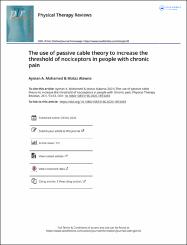| dc.contributor.author | Mohamed, Ayman A. | |
| dc.contributor.author | Alawna, Motaz | |
| dc.date.accessioned | 2023-09-25T08:55:04Z | |
| dc.date.available | 2023-09-25T08:55:04Z | |
| dc.date.issued | 2021 | en_US |
| dc.identifier.issn | 1083-3196 | |
| dc.identifier.issn | 1743-288X | |
| dc.identifier.uri | https://hdl.handle.net/11363/5650 | |
| dc.description.abstract | Background: Chronic pain is one of the disorders that cost any society high expenses. The
major mechanisms responsible for the conversion of pain from acute to chronic are still
unclear. One major mechanism of these mechanisms is the hypersensitivity of nociceptors to
any noxious stimulus. Treatment approaches for chronic pain have not targeted the abnormal function of nociceptors or achieved long-time relief of pain yet.
Objectives: To outline the effectiveness of passive cable theory to decrease the hypersensitivity of nociceptors in patients with chronic pain and renormalize the abnormal hypersensitivity of nociceptors.
Major Findings: applying the concept of the passive cable theory in the treatment of
chronic pain would decrease the hypersensitivity of nociceptors and produce a decrease in
chronic pain levels. This could occur through increasing the passive background leakage of
ions in the opposite direction against their major flow direction. During the major flow of
ions through the cell membrane occurs with any noxious stimulus, a background passive
leakage of the same ions occurs in the opposite direction. This leakage helps in increasing
the postsynaptic potentials and prolongs their decay phase. In turn, this decreases the
hyperexcitability of the central nervous system, which commonly occurs in chronic pain.
Both decreases in the peripheral and central sensitization would decrease the depletion of
b-arrestin-2, which leads to a decrease in the descending painful mechanism.
Conclusion: The use of passive cable theory would be a useful intervention to decrease the
hypersensitivity of peripheral nociceptors and hyper-excitability of the central nervous system, which are common mechanisms of persisted chronic pain. This helps to renormalize
the abnormal mechanism commonly occur in chronic pain and would cause a prolonged
decrease in chronic pain. | en_US |
| dc.language.iso | eng | en_US |
| dc.publisher | TAYLOR & FRANCIS LTD, 2-4 PARK SQUARE, MILTON PARK, ABINGDON OR14 4RN, OXON, ENGLAND | en_US |
| dc.relation.isversionof | 10.1080/10833196.2020.1853493 | en_US |
| dc.rights | info:eu-repo/semantics/openAccess | en_US |
| dc.rights | Attribution-NonCommercial-NoDerivs 3.0 United States | * |
| dc.rights.uri | http://creativecommons.org/licenses/by-nc-nd/3.0/us/ | * |
| dc.subject | Chronic pain | en_US |
| dc.subject | nociceptors | en_US |
| dc.subject | passive cable theory | en_US |
| dc.subject | threshold | en_US |
| dc.title | The use of passive cable theory to increase the threshold of nociceptors in people with chronic pain | en_US |
| dc.type | article | en_US |
| dc.relation.ispartof | Physical Therapy Reviews | en_US |
| dc.department | Sağlık Bilimleri Fakültesi | en_US |
| dc.authorid | https://orcid.org/0000-0001-5092-3549 | en_US |
| dc.authorid | https://orcid.org/0000-0002-4936-373X | en_US |
| dc.identifier.volume | 26 | en_US |
| dc.identifier.issue | 1 | en_US |
| dc.identifier.startpage | 53 | en_US |
| dc.identifier.endpage | 63 | en_US |
| dc.relation.publicationcategory | Makale - Uluslararası Hakemli Dergi - Kurum Öğretim Elemanı | en_US |
| dc.contributor.institutionauthor | Mohamed, Ayman A. | |
| dc.contributor.institutionauthor | Alawna, Motaz | |



















